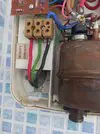I will freely admit having a power shower is far better than an instant shower. But having fitted one, it is not an easy option. With gravity giving the pressure to the water, it is simply not enough with most homes, so it needs a pump, (power shower) but first consideration is can it draw water away from any immersion heater? So the tapping into the water system has to be high enough so it can't drain the tank with the immersion in.
In the main, this means all new pipe work to the power shower, this is rather expensive, remember cold as well as hot, as want both at same pressure. The next problem is having enough hot water to run the shower, my immersion only goes down 9" into the cistern, enough for handwashing, not enough for a shower, so the immersion heater will likely need changing.
If you have a mains pressure cistern, it needs testing every year, so not a good idea, you can get cisterns where the heat exchanger pipe is mains pressure, but cistern gravity fed, this is far more contact area to a standard hot coil, so it often means new cistern.
So looking at a shower downstairs, where there is enough pressure, or a power shower, or new cistern, however it is done, looking at a lot of money, as to using a direct gas boiler, yes had this in last house, but not without problems, although the boiler can modulate, it was limited as to how much, so one needed a large shower rose to ensure enough hot water flows in the summer months so boiler does not cut out.
As to a combi boiler even more problems, the Bosch on in parent's house had two options, eco off or on. With the eco off, the shower worked OK, but with eco on, the shower would start cold, get hot, then go cold again, then finally hot again. But, with eco off using all other taps they had to be full on, or the boiler would not fire up.
As to cost, any hot water in the pipes is wasted heat, and boilers are not 100% efficient, so there is no direct comparison, so if one has to wait 3 minutes for water to get hot, cold and hot again, that is 3 minutes of wasted heat. I am sure it would be cheaper for the females, but I will go for a quick shower, likely 7 minutes, so an instant gas shower, likely uses 30% more water or more since a bigger shower head, very likely more, so cost wise gas is not as cheap as one first thinks.
I will admit the power shower installed in mother's wet room was the best shower I have ever had, however the installation was far from easy or cheap. And when the boiler was changed, it had to be ripped out again, as all water direct from mains, so illegal to use a power shower direct from mains.
In view of that,
The upgrade is to get rid of the electric shower and fit a proper one.
How is hot water supplied to other outlets?
is rather a blinkered approch, I would say consider a thermostatic shower control from the domestic hot water, as in the main that is better, but one needs to weigh up the pros and cons. I was rather supprised with this house how good the instent electric shower is, I would say the important thing is the shower head is matched to the shower output. With the power shower and instent gas, the shower head was fixed, it could be removed for washing down wet room, but it had that much force, hand held while showing water would go everywhere, but with electric instant the power is a lot less, so no problem removing head to wash under arms, if one drops it, it falls to lenght of hose and you can pick it up again, the power shower if dropped would fly everywhere, like a demented snake. Hense not removed for showing.
OK, from the stored water supply you can have something like this,
one good reason for not having a combi boiler, but one must consider the cost to install it. And she looks high maintenance to me. Clearly in a wet room, and most have a shower in the bath. But we have no idea if
@RrogerD has a domestic hot water tank, a combi boiler, or even if they have gas or oil, and more important to question size of cable to shower, or even size of supply to home, so really not much more can be said.


